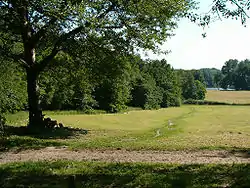Jakoba Mulder
Jakoba Helena Mulder (Breda, 2 March 1900 – Amsterdam, 5 November 1988) was a Dutch architect and urban planner remembered for her designs of two large city parks and the creation of livable housing and play spaces in Amsterdam.
Jakoba Helena Mulder | |
|---|---|
_(cropped).jpg.webp) Jakoba (Ko) Mulder in 1968 | |
| Born | 2 March 1900 Breda, Netherlands |
| Died | 5 November 1988 Amsterdam, Netherlands |
| Nationality | Dutch |
| Other names | Ko Mulder |
| Alma mater | Delft University of Technology |
| Occupation(s) | Architect and urban planner |
| Parents |
|
Biography
When she was 18, Ko Mulder enrolled in the architecture program at the Delft University of Technology as "one of the first girls to apply to study architecture."[1] She completed her degree as a construction engineer in 1926 and was the first female to graduate in the urban design program.[2][3] According to Dijksterhuis, she met with early success.
When she won a fire station design competition after graduation, her anonymously submitted design was praised for its 'masculine toughness.' The surprise was great when it turned out that the maker was a woman.[1]
In 1926, she was hired by the municipality of Delft to work as a deputy architect on several projects including expansion plans for the town.[4] In 1930, she joined the Amsterdam urban development department as an assistant to the urban development architect and supervising 30 male artists.[4] There she worked for Theodoor K. van Lohuizen and Cornelis van Eesteren, among others.[5]

Amsterdamse Bos park
Mulder's first big assignment was the design of Amsterdamse Bos, a 200-acre space in the city that was three times the size of New York’s Central Park. From 1935 until its completion in 1970, Jakoba Mulder was head of the team of various experts in soil science, water management, flora and fauna, and also in sports, nature education and public health.[5]
Throughout her life, she was popularly known as "Miss of the Bos" because of her work and continuing interest in the design of the famously wooded park.[1][6]
Beatrix Park
From 1936 to 1939, she designed the city's Beatrix Park, which was named in 1938 after the newly born Princess Beatrix.[1][4]
.jpg.webp)
The park now features a monument erected in Mulder's honor titled Future Past Glory. It was designed by the artists Liet Heringa and Maarten van Kalsbeek and installed in 2018.[1]
Playgrounds
Beginning in 1947, while rebuilding Amsterdam after the devastation of World War II, Mulder was involved in the design of open spaces in cityscapes, preferably for children's play areas.[4][7][8] To realize her vision, she worked with the architect Aldo van Eyck who designed playground equipment to fill Mulder's open spaces near new residential apartments, which were themselves creatively situated.[4] According to Dijksterhuis,
She therefore designed a system of hooks and courts: two L-shaped residential blocks that interlock. This resulted in a much more varied picture and more light in the houses. In addition, playgrounds were built in courtyards that mothers could see from the kitchen.[1]
Together van Eyck and Mulder collaborated on more than 700 play spaces in Amsterdam.[1][8][9] One example of her play area design that remains today is the Gibraltar Street wading pool that Mulder designed and that still opens every summer.[2][4]
In 1952 she was named chief architect of Amsterdam and in 1958 succeeded her mentor Cornelis van Eesteren to become head of the city's urban development department where she remained until her retirement in 1965.[1][2]
Personal life
Mulder was born to an infantry officer, Hendrik Mulder (1874-1947), and Sara Maria Boon (1878-1943). Because her father was serving in the Royal Dutch Indian Army, she grew up living in Semarang, Dutch East Indies. She left Indonesia for the Netherlands when she was 13 so she could attend school, living with her aunts and uncles.
She never married and even after retiring from her position with the city, she remained a professor of planning at the University of Amsterdam until her 70th birthday. During her time there, she actively encouraged young women to follow her into the design professions, as noted in a 1947 professional guide, "she praised the 'men's profession' of urban design as very suitable for women."[1]
She was honored as a member of the Order of Orange-Nassau.
Selected projects
References
- Dijksterhuis, Edo (2018-10-12). "Monument voor Jakoba Mulder in 'haar' Beatrixpark". Het Parool (in Dutch). Retrieved 2020-12-23.
- "Research : Studio Linda Vlassenrood" (in Dutch). Retrieved 2020-12-28.
- Seražin, Helena; Garda, Emilia Maria; Franchini, Caterina (2018-06-13). Women's Creativity since the Modern Movement (1918-2018): Toward a New Perception and Reception. Založba ZRC. pp. 456–460. ISBN 978-961-05-0106-0.
- Lefaivre, Liane (2007). Ground-up City: Play as a Design Tool. 010 Publishers. ISBN 978-90-6450-602-4.
- Amsterdam. "History of the Amsterdamse Bos". Amsterdamse Bos (in Dutch). Retrieved 2021-01-30.
- Ruff, Allan R. (2015-10-31). Arcadian Visions: Pastoral Influences on Poetry, Painting and the Design of Landscape. Windgather Press. ISBN 978-1-909686-67-0.
- González, María Cristina García; Guerrero, Salvador (2019). "Sobre el espacio de juego infantil en la ciudad moderna: Lady Allen of Hurtwood "versus" Jakoba Mulder". Ciudad y Territorio: Estudios Territoriales (in Spanish) (200): 311–326. ISSN 1133-4762.
- Hall, George, and Lefaivre, Liane. Ground-up City: Play as a Design Tool. Netherlands, 010 Publishers, 2007.
- Benrachi, Bouba; Lezzar, Samir (2013-05-24). "The impact of building modifications on Algerian social collective housing". International Journal of Urban Sustainable Development. 6 (1): 123–132. doi:10.1080/19463138.2013.780176. ISSN 1946-3138. S2CID 154950658.